Advantages and Limitations of Social Policy Methods in Society
VerifiedAdded on 2022/12/27
|5
|1484
|100
Essay
AI Summary
This essay delves into the multifaceted world of social policy, meticulously examining its advantages and limitations within a societal context. It begins by defining social policy and its crucial role in shaping welfare and social safety nets, highlighting its evolution influenced by religious, scientific, and ideological shifts. The essay then outlines the advantages of welfare states, emphasizing humanitarian approaches, mutual social responsibility, and the promotion of social protection and economic advantages, including reduced poverty and enhanced social harmony. Conversely, it critically analyzes the disadvantages, such as potential infringements on individual freedom, dependency traps, and the creation of class warfare and inequality due to the redistribution of resources. The conclusion underscores the importance of social policy in modern societies, particularly in Australia, while acknowledging the need for strategies to combat unemployment and ensure welfare reaches those who need it most.
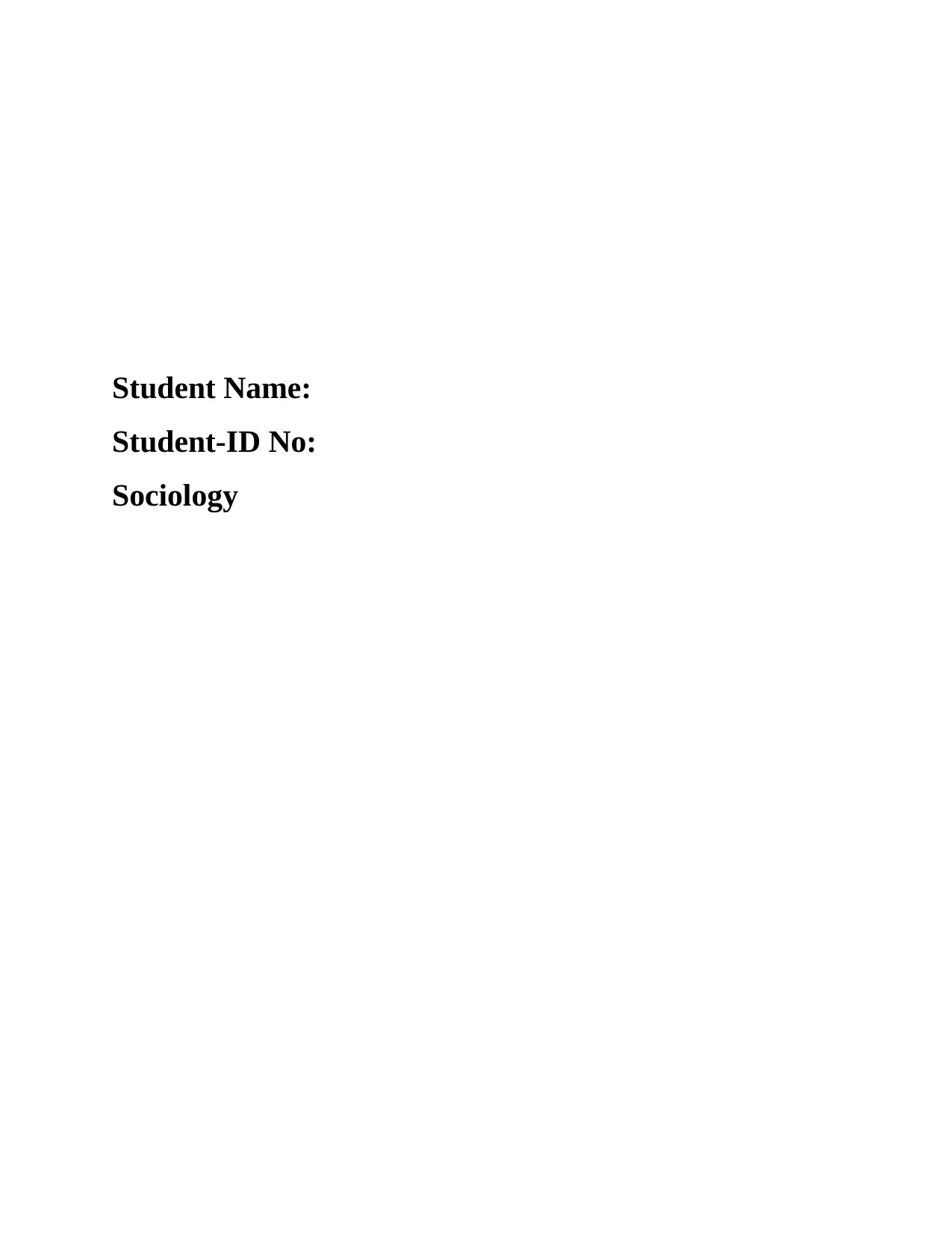
Student Name:
Student-ID No:
Sociology
Student-ID No:
Sociology
Paraphrase This Document
Need a fresh take? Get an instant paraphrase of this document with our AI Paraphraser
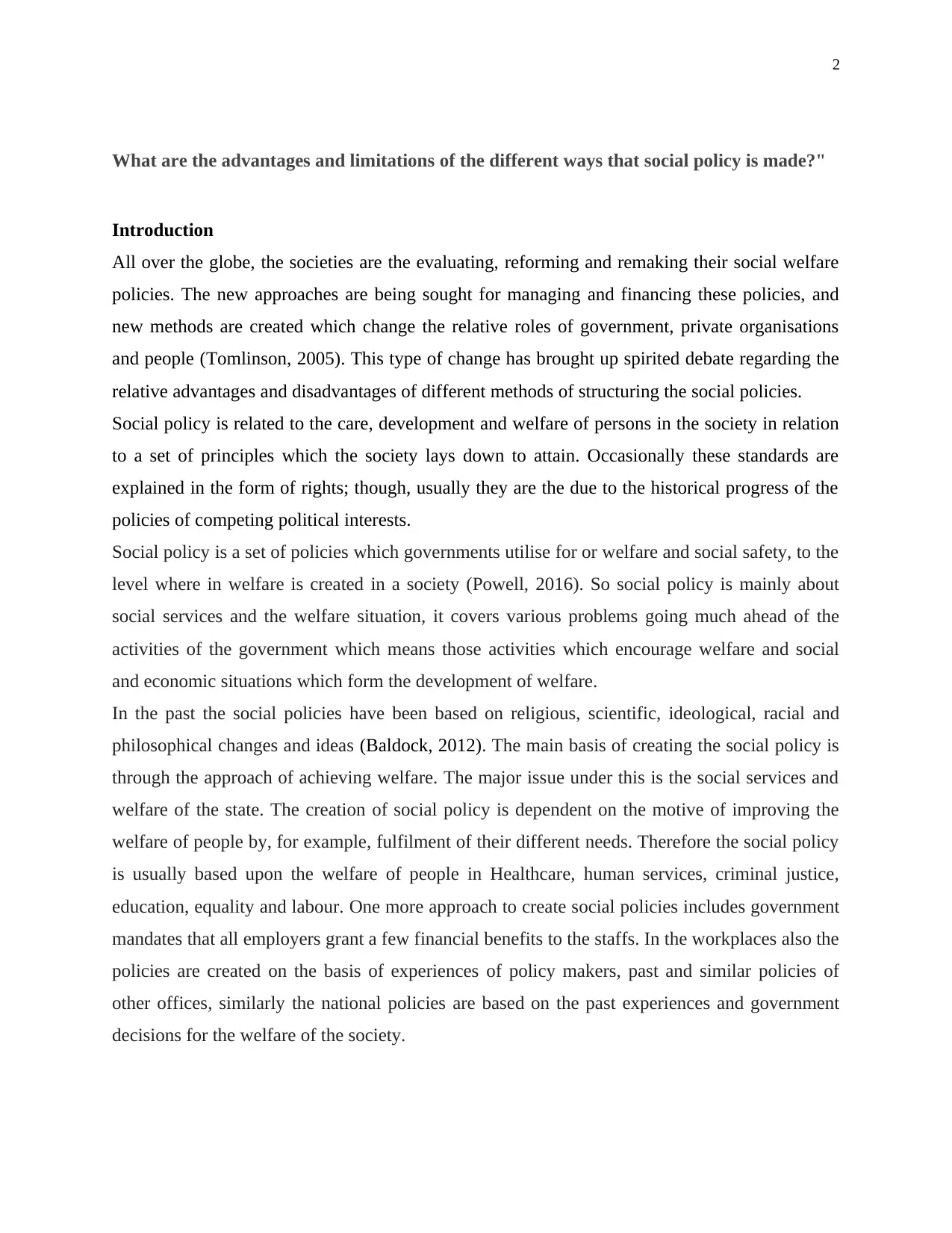
2
What are the advantages and limitations of the different ways that social policy is made?"
Introduction
All over the globe, the societies are the evaluating, reforming and remaking their social welfare
policies. The new approaches are being sought for managing and financing these policies, and
new methods are created which change the relative roles of government, private organisations
and people (Tomlinson, 2005). This type of change has brought up spirited debate regarding the
relative advantages and disadvantages of different methods of structuring the social policies.
Social policy is related to the care, development and welfare of persons in the society in relation
to a set of principles which the society lays down to attain. Occasionally these standards are
explained in the form of rights; though, usually they are the due to the historical progress of the
policies of competing political interests.
Social policy is a set of policies which governments utilise for or welfare and social safety, to the
level where in welfare is created in a society (Powell, 2016). So social policy is mainly about
social services and the welfare situation, it covers various problems going much ahead of the
activities of the government which means those activities which encourage welfare and social
and economic situations which form the development of welfare.
In the past the social policies have been based on religious, scientific, ideological, racial and
philosophical changes and ideas (Baldock, 2012). The main basis of creating the social policy is
through the approach of achieving welfare. The major issue under this is the social services and
welfare of the state. The creation of social policy is dependent on the motive of improving the
welfare of people by, for example, fulfilment of their different needs. Therefore the social policy
is usually based upon the welfare of people in Healthcare, human services, criminal justice,
education, equality and labour. One more approach to create social policies includes government
mandates that all employers grant a few financial benefits to the staffs. In the workplaces also the
policies are created on the basis of experiences of policy makers, past and similar policies of
other offices, similarly the national policies are based on the past experiences and government
decisions for the welfare of the society.
What are the advantages and limitations of the different ways that social policy is made?"
Introduction
All over the globe, the societies are the evaluating, reforming and remaking their social welfare
policies. The new approaches are being sought for managing and financing these policies, and
new methods are created which change the relative roles of government, private organisations
and people (Tomlinson, 2005). This type of change has brought up spirited debate regarding the
relative advantages and disadvantages of different methods of structuring the social policies.
Social policy is related to the care, development and welfare of persons in the society in relation
to a set of principles which the society lays down to attain. Occasionally these standards are
explained in the form of rights; though, usually they are the due to the historical progress of the
policies of competing political interests.
Social policy is a set of policies which governments utilise for or welfare and social safety, to the
level where in welfare is created in a society (Powell, 2016). So social policy is mainly about
social services and the welfare situation, it covers various problems going much ahead of the
activities of the government which means those activities which encourage welfare and social
and economic situations which form the development of welfare.
In the past the social policies have been based on religious, scientific, ideological, racial and
philosophical changes and ideas (Baldock, 2012). The main basis of creating the social policy is
through the approach of achieving welfare. The major issue under this is the social services and
welfare of the state. The creation of social policy is dependent on the motive of improving the
welfare of people by, for example, fulfilment of their different needs. Therefore the social policy
is usually based upon the welfare of people in Healthcare, human services, criminal justice,
education, equality and labour. One more approach to create social policies includes government
mandates that all employers grant a few financial benefits to the staffs. In the workplaces also the
policies are created on the basis of experiences of policy makers, past and similar policies of
other offices, similarly the national policies are based on the past experiences and government
decisions for the welfare of the society.
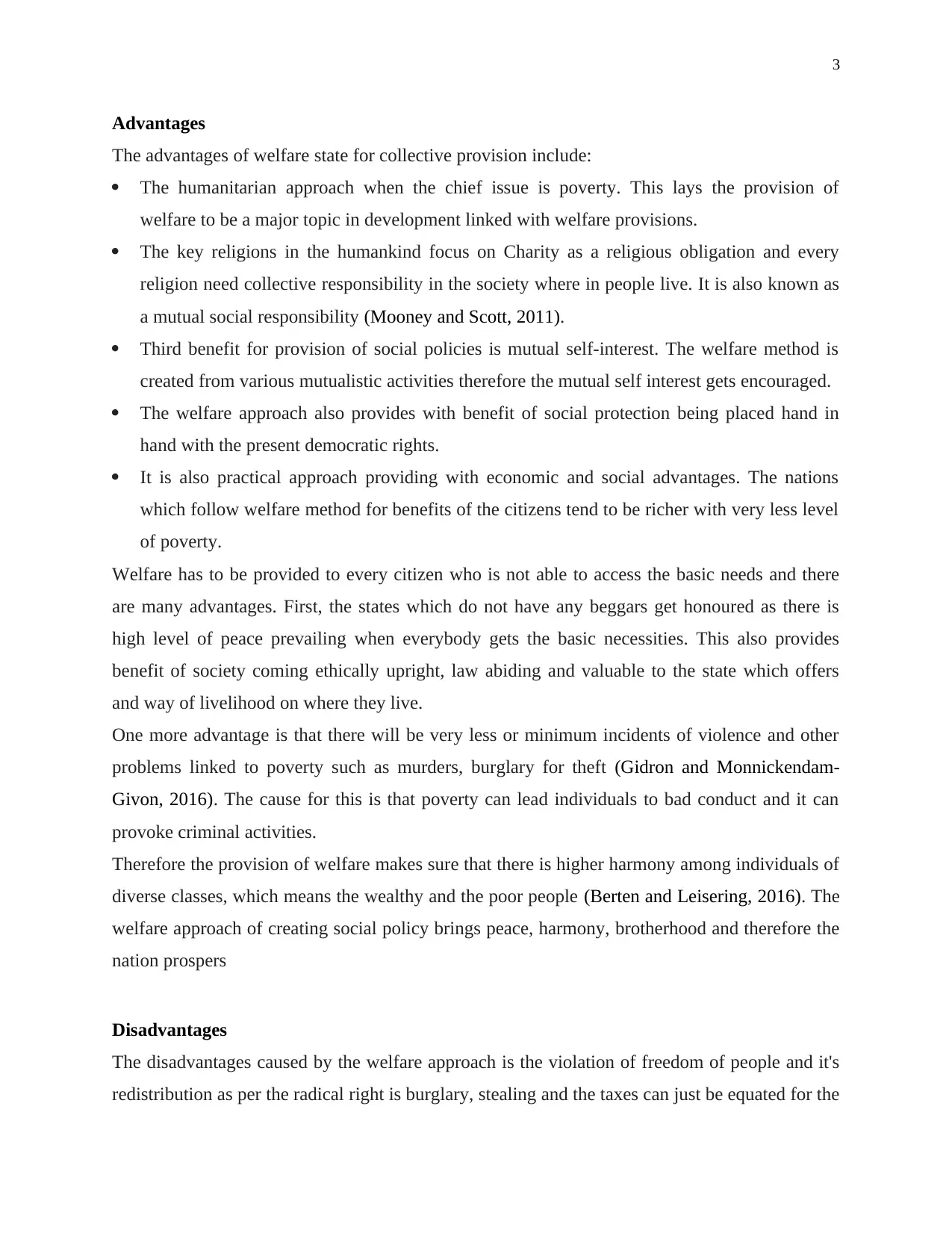
3
Advantages
The advantages of welfare state for collective provision include:
The humanitarian approach when the chief issue is poverty. This lays the provision of
welfare to be a major topic in development linked with welfare provisions.
The key religions in the humankind focus on Charity as a religious obligation and every
religion need collective responsibility in the society where in people live. It is also known as
a mutual social responsibility (Mooney and Scott, 2011).
Third benefit for provision of social policies is mutual self-interest. The welfare method is
created from various mutualistic activities therefore the mutual self interest gets encouraged.
The welfare approach also provides with benefit of social protection being placed hand in
hand with the present democratic rights.
It is also practical approach providing with economic and social advantages. The nations
which follow welfare method for benefits of the citizens tend to be richer with very less level
of poverty.
Welfare has to be provided to every citizen who is not able to access the basic needs and there
are many advantages. First, the states which do not have any beggars get honoured as there is
high level of peace prevailing when everybody gets the basic necessities. This also provides
benefit of society coming ethically upright, law abiding and valuable to the state which offers
and way of livelihood on where they live.
One more advantage is that there will be very less or minimum incidents of violence and other
problems linked to poverty such as murders, burglary for theft (Gidron and Monnickendam-
Givon, 2016). The cause for this is that poverty can lead individuals to bad conduct and it can
provoke criminal activities.
Therefore the provision of welfare makes sure that there is higher harmony among individuals of
diverse classes, which means the wealthy and the poor people (Berten and Leisering, 2016). The
welfare approach of creating social policy brings peace, harmony, brotherhood and therefore the
nation prospers
Disadvantages
The disadvantages caused by the welfare approach is the violation of freedom of people and it's
redistribution as per the radical right is burglary, stealing and the taxes can just be equated for the
Advantages
The advantages of welfare state for collective provision include:
The humanitarian approach when the chief issue is poverty. This lays the provision of
welfare to be a major topic in development linked with welfare provisions.
The key religions in the humankind focus on Charity as a religious obligation and every
religion need collective responsibility in the society where in people live. It is also known as
a mutual social responsibility (Mooney and Scott, 2011).
Third benefit for provision of social policies is mutual self-interest. The welfare method is
created from various mutualistic activities therefore the mutual self interest gets encouraged.
The welfare approach also provides with benefit of social protection being placed hand in
hand with the present democratic rights.
It is also practical approach providing with economic and social advantages. The nations
which follow welfare method for benefits of the citizens tend to be richer with very less level
of poverty.
Welfare has to be provided to every citizen who is not able to access the basic needs and there
are many advantages. First, the states which do not have any beggars get honoured as there is
high level of peace prevailing when everybody gets the basic necessities. This also provides
benefit of society coming ethically upright, law abiding and valuable to the state which offers
and way of livelihood on where they live.
One more advantage is that there will be very less or minimum incidents of violence and other
problems linked to poverty such as murders, burglary for theft (Gidron and Monnickendam-
Givon, 2016). The cause for this is that poverty can lead individuals to bad conduct and it can
provoke criminal activities.
Therefore the provision of welfare makes sure that there is higher harmony among individuals of
diverse classes, which means the wealthy and the poor people (Berten and Leisering, 2016). The
welfare approach of creating social policy brings peace, harmony, brotherhood and therefore the
nation prospers
Disadvantages
The disadvantages caused by the welfare approach is the violation of freedom of people and it's
redistribution as per the radical right is burglary, stealing and the taxes can just be equated for the
⊘ This is a preview!⊘
Do you want full access?
Subscribe today to unlock all pages.

Trusted by 1+ million students worldwide
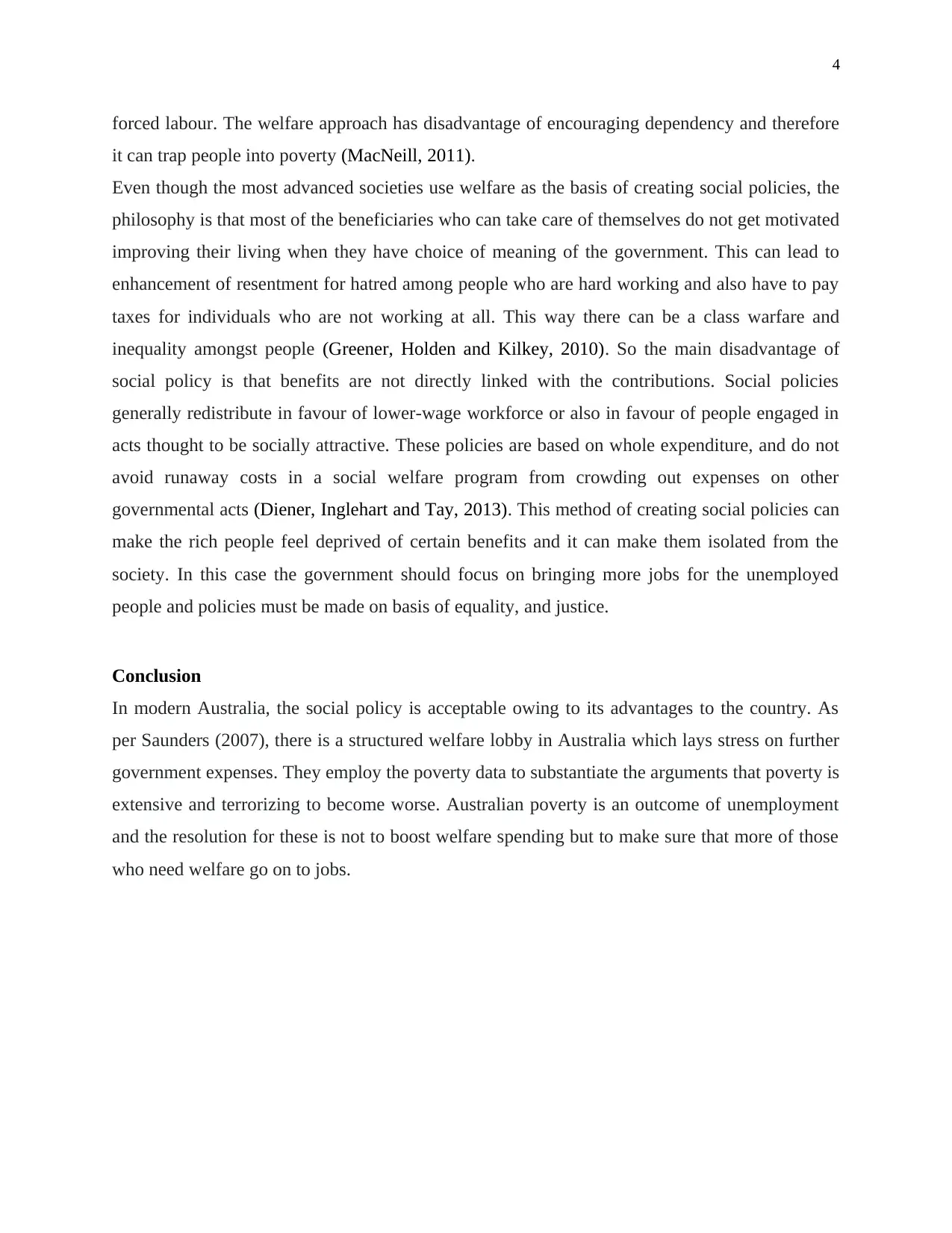
4
forced labour. The welfare approach has disadvantage of encouraging dependency and therefore
it can trap people into poverty (MacNeill, 2011).
Even though the most advanced societies use welfare as the basis of creating social policies, the
philosophy is that most of the beneficiaries who can take care of themselves do not get motivated
improving their living when they have choice of meaning of the government. This can lead to
enhancement of resentment for hatred among people who are hard working and also have to pay
taxes for individuals who are not working at all. This way there can be a class warfare and
inequality amongst people (Greener, Holden and Kilkey, 2010). So the main disadvantage of
social policy is that benefits are not directly linked with the contributions. Social policies
generally redistribute in favour of lower-wage workforce or also in favour of people engaged in
acts thought to be socially attractive. These policies are based on whole expenditure, and do not
avoid runaway costs in a social welfare program from crowding out expenses on other
governmental acts (Diener, Inglehart and Tay, 2013). This method of creating social policies can
make the rich people feel deprived of certain benefits and it can make them isolated from the
society. In this case the government should focus on bringing more jobs for the unemployed
people and policies must be made on basis of equality, and justice.
Conclusion
In modern Australia, the social policy is acceptable owing to its advantages to the country. As
per Saunders (2007), there is a structured welfare lobby in Australia which lays stress on further
government expenses. They employ the poverty data to substantiate the arguments that poverty is
extensive and terrorizing to become worse. Australian poverty is an outcome of unemployment
and the resolution for these is not to boost welfare spending but to make sure that more of those
who need welfare go on to jobs.
forced labour. The welfare approach has disadvantage of encouraging dependency and therefore
it can trap people into poverty (MacNeill, 2011).
Even though the most advanced societies use welfare as the basis of creating social policies, the
philosophy is that most of the beneficiaries who can take care of themselves do not get motivated
improving their living when they have choice of meaning of the government. This can lead to
enhancement of resentment for hatred among people who are hard working and also have to pay
taxes for individuals who are not working at all. This way there can be a class warfare and
inequality amongst people (Greener, Holden and Kilkey, 2010). So the main disadvantage of
social policy is that benefits are not directly linked with the contributions. Social policies
generally redistribute in favour of lower-wage workforce or also in favour of people engaged in
acts thought to be socially attractive. These policies are based on whole expenditure, and do not
avoid runaway costs in a social welfare program from crowding out expenses on other
governmental acts (Diener, Inglehart and Tay, 2013). This method of creating social policies can
make the rich people feel deprived of certain benefits and it can make them isolated from the
society. In this case the government should focus on bringing more jobs for the unemployed
people and policies must be made on basis of equality, and justice.
Conclusion
In modern Australia, the social policy is acceptable owing to its advantages to the country. As
per Saunders (2007), there is a structured welfare lobby in Australia which lays stress on further
government expenses. They employ the poverty data to substantiate the arguments that poverty is
extensive and terrorizing to become worse. Australian poverty is an outcome of unemployment
and the resolution for these is not to boost welfare spending but to make sure that more of those
who need welfare go on to jobs.
Paraphrase This Document
Need a fresh take? Get an instant paraphrase of this document with our AI Paraphraser
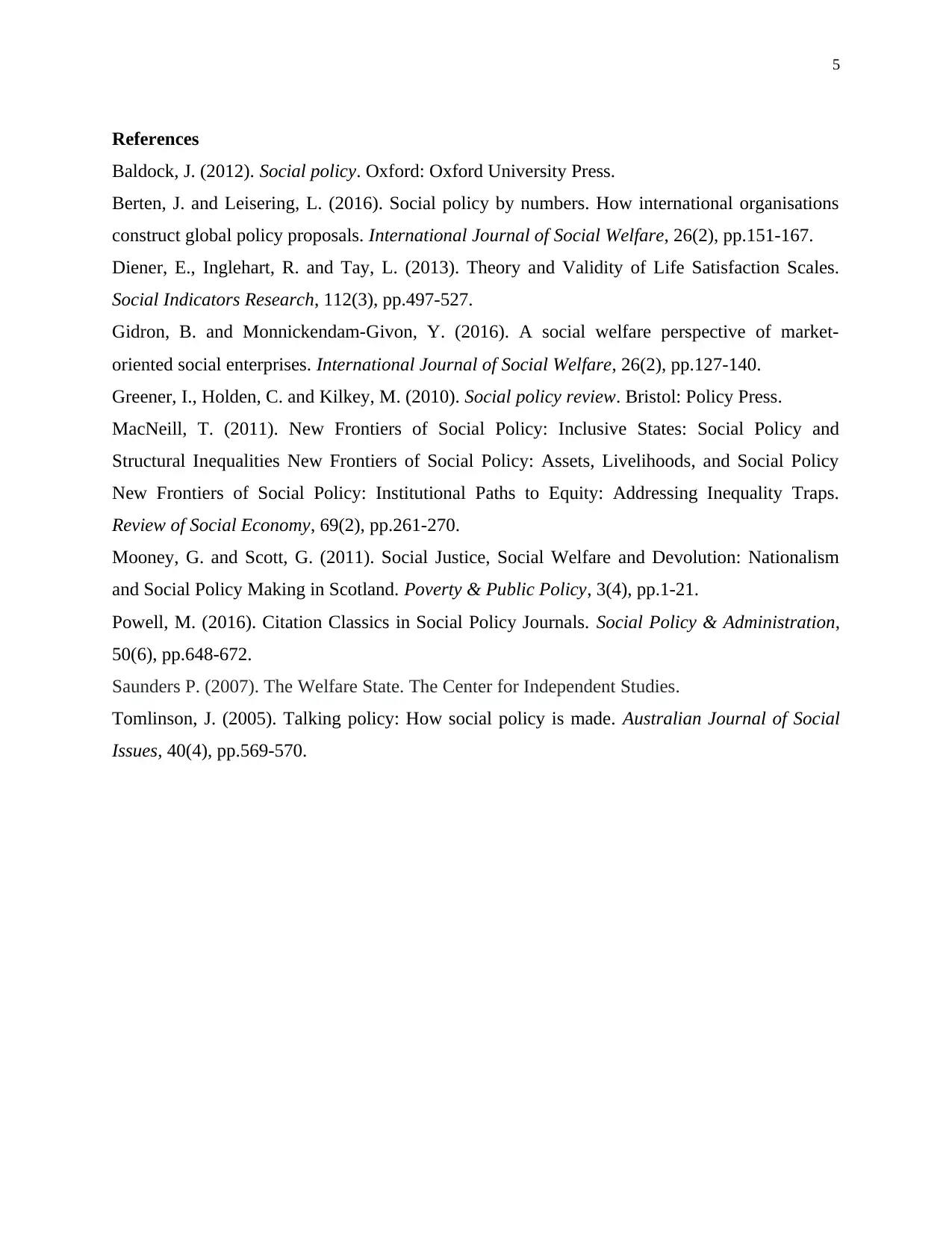
5
References
Baldock, J. (2012). Social policy. Oxford: Oxford University Press.
Berten, J. and Leisering, L. (2016). Social policy by numbers. How international organisations
construct global policy proposals. International Journal of Social Welfare, 26(2), pp.151-167.
Diener, E., Inglehart, R. and Tay, L. (2013). Theory and Validity of Life Satisfaction Scales.
Social Indicators Research, 112(3), pp.497-527.
Gidron, B. and Monnickendam-Givon, Y. (2016). A social welfare perspective of market-
oriented social enterprises. International Journal of Social Welfare, 26(2), pp.127-140.
Greener, I., Holden, C. and Kilkey, M. (2010). Social policy review. Bristol: Policy Press.
MacNeill, T. (2011). New Frontiers of Social Policy: Inclusive States: Social Policy and
Structural Inequalities New Frontiers of Social Policy: Assets, Livelihoods, and Social Policy
New Frontiers of Social Policy: Institutional Paths to Equity: Addressing Inequality Traps.
Review of Social Economy, 69(2), pp.261-270.
Mooney, G. and Scott, G. (2011). Social Justice, Social Welfare and Devolution: Nationalism
and Social Policy Making in Scotland. Poverty & Public Policy, 3(4), pp.1-21.
Powell, M. (2016). Citation Classics in Social Policy Journals. Social Policy & Administration,
50(6), pp.648-672.
Saunders P. (2007). The Welfare State. The Center for Independent Studies.
Tomlinson, J. (2005). Talking policy: How social policy is made. Australian Journal of Social
Issues, 40(4), pp.569-570.
References
Baldock, J. (2012). Social policy. Oxford: Oxford University Press.
Berten, J. and Leisering, L. (2016). Social policy by numbers. How international organisations
construct global policy proposals. International Journal of Social Welfare, 26(2), pp.151-167.
Diener, E., Inglehart, R. and Tay, L. (2013). Theory and Validity of Life Satisfaction Scales.
Social Indicators Research, 112(3), pp.497-527.
Gidron, B. and Monnickendam-Givon, Y. (2016). A social welfare perspective of market-
oriented social enterprises. International Journal of Social Welfare, 26(2), pp.127-140.
Greener, I., Holden, C. and Kilkey, M. (2010). Social policy review. Bristol: Policy Press.
MacNeill, T. (2011). New Frontiers of Social Policy: Inclusive States: Social Policy and
Structural Inequalities New Frontiers of Social Policy: Assets, Livelihoods, and Social Policy
New Frontiers of Social Policy: Institutional Paths to Equity: Addressing Inequality Traps.
Review of Social Economy, 69(2), pp.261-270.
Mooney, G. and Scott, G. (2011). Social Justice, Social Welfare and Devolution: Nationalism
and Social Policy Making in Scotland. Poverty & Public Policy, 3(4), pp.1-21.
Powell, M. (2016). Citation Classics in Social Policy Journals. Social Policy & Administration,
50(6), pp.648-672.
Saunders P. (2007). The Welfare State. The Center for Independent Studies.
Tomlinson, J. (2005). Talking policy: How social policy is made. Australian Journal of Social
Issues, 40(4), pp.569-570.
1 out of 5
Related Documents
Your All-in-One AI-Powered Toolkit for Academic Success.
+13062052269
info@desklib.com
Available 24*7 on WhatsApp / Email
![[object Object]](/_next/static/media/star-bottom.7253800d.svg)
Unlock your academic potential
Copyright © 2020–2025 A2Z Services. All Rights Reserved. Developed and managed by ZUCOL.





